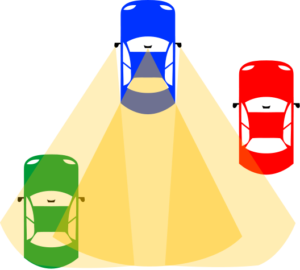Blind Spot Awareness | The Key to Safer Driving
| Driving Lessons |
Driving safely is a multifaceted skill, requiring not only adherence to traffic rules but also a keen awareness of your vehicle and its surroundings. A critical aspect of this is understanding and managing blind spots. The California Driver Handbook provides valuable guidance in this area, emphasizing the importance of recognizing blind spots while driving. This blog post integrates these insights with practical advice to enhance your blind spot awareness, a key to safer lane changes and merging in traffic.
This blog may contain affiliate links, and therefore if you make a purchase through these links, we subsequently may or may not earn a commission at no extra cost to you.
What are Blind Spots?
Blind spots are areas around your vehicle that are not visible through your rearview and side mirrors. In most vehicles, these are typically located around the area next to your back tires, extending approximately the length of an average car. It’s essential for drivers to understand that these areas exist in all types of vehicles, regardless of size.
Proper Mirror Adjustment | Your First Line of Defense
Here’s how to adjust mirrors effectively:
- Rearview Mirror: Adjust it to have a full, centered view of your rear window.
- Side Mirrors: Angle them to cover the space that your rearview mirror can’t. When a vehicle exits the view of your rearview mirror, it should immediately enter the view of your side mirror.
Despite these adjustments, complete elimination of blind spots isn’t possible, making physical checks a necessary habit.
Physical Checks: Beyond Mirror Adjustments
- Use Mirrors First: Always start by checking your mirrors for an initial assessment of the traffic.
- Shoulder Check: Perform a quick glance over your shoulder to ensure the space is clear before changing lanes or merging.
Key Safety Tips for Managing Blind Spots
- Continuous Awareness: Keep track of vehicles around you, particularly those that may enter or exit your blind spots.
- Early Signaling: Communicate your driving intentions well in advance using turn signals.
- Avoid Driving in Others’ Blind Spots: Especially important when driving near larger vehicles like trucks, where blind spots are significantly larger.
- Leverage Technology: If your car is equipped with blind spot detection systems, use them as an additional safety feature but not as a sole reliance.
Blind Spot Awareness | The Key to Safer Driving
Understanding and managing blind spots is an essential skill for safe driving. The guidelines from the California Driver Handbook, combined with these practical tips, can help reduce the risks associated with blind spots. Safe driving requires proactive awareness and a commitment to considering the safety of all road users. Remember, effective driving is not just about following rules; it’s about cultivating habits that ensure safety for everyone on the road.
Drive with Confidence!
Keep up with all the latest driving news. Expolre our blog packed with essential tips and expert advice on all things related to DRIVING!






